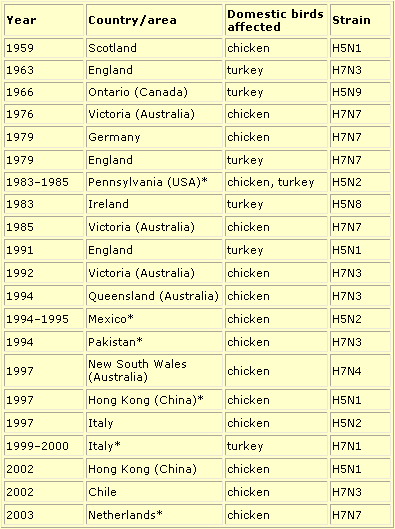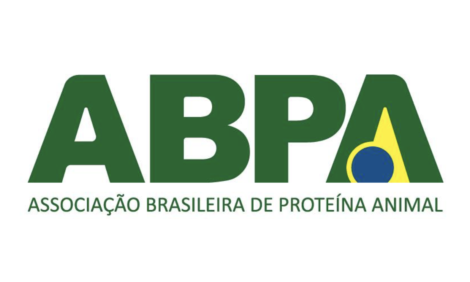



Avian influenza A(H5N1) - FAO update 31
Situation in Asia: need for a long-term response, comparison with previous outbreaks - During last week’s emergency meeting in Bangkok, Thailand, officials from FAO, OIE, and WHO drew attention to several unique features of the current outbreaks of H5N1 in poultry in Asia in particular its geographic distribution, rate of spread and severity of which are unprecedented.
 Prospects for rapid control are inconsistent with worldwide experience, over more than four decades, with previous outbreaks, which have all been much smaller in scope and inherently less challenging. Even in countries with good surveillance, adequate resources, and geographically limited outbreaks, control has often taken up to two years. For these reasons and others, WHO has cautioned against assumptions that the outbreaks can be controlled in the immediate future.
Prospects for rapid control are inconsistent with worldwide experience, over more than four decades, with previous outbreaks, which have all been much smaller in scope and inherently less challenging. Even in countries with good surveillance, adequate resources, and geographically limited outbreaks, control has often taken up to two years. For these reasons and others, WHO has cautioned against assumptions that the outbreaks can be controlled in the immediate future.
WHO has described the serious public health implications of these outbreaks in a previous update.
Up to the end of 2003, highly pathogenic avian influenza (HPAI) has been considered a rare disease. Since 1959, only 21 Outbreaks had been reported worldwide. The majority occurred in Europe and the Americas. Of the total, only five resulted in significant spread to numerous farms, and only one was associated with spread to other countries.
Since mid-December 2003, eight Asian countries have confirmed outbreaks of highly pathogenic avian influenza caused by the H5N1 strain. Most of these countries are experiencing outbreaks of this disease for the first time in their histories. In several, outbreaks have been detected in virtually every part of the country
Over the past two months, more than 100 million birds have either died of the disease or been culled in Asia. This figure is greater than the total number of poultry affected, over years, in the world’s previous five largest outbreaks combined.
Worldwide experience since 1959 supports official statements about the unprecedented nature of the present situation and the unique challenges for control. Unique features in the present situation include:
Concentration of poultry in backyard farms. In several countries experiencing outbreaks, up to 80% of poultry are produced on small farms and backyard holdings in rural areas, where poultry range freely. In China, 60% of the country’s esitmated 13.2 billion chickens are raised on small farms in close proximity to humans and domestic animals, including pigs. This situation makes implementation of strict control measures, essential to the control of previous outbreaks, extremely difficult. These control measures – including bird-proof, ecologically controlled housing, disinfection of all incoming persons, equipment, and vehicles, prevention of contact with insects, rodents, and other mechanical vectors – cannot be applied on small rural farms and backyard holdings.
Economic significance of poultry production. Poultry production contributes greatly to the economies and food supplies of affected countries. The agricultural sector faces the challenge of minimizing losses to industry and subsistence farmers in ways that also reduce health risks for humans. Because many people in the region are so dependent on poultry, appropriate culling may be difficult to implement.
Lack of control experience. Since the disease is new to most countries in the region, very little experience exists at national and international levels to guide the best country-specific control measures. In some countries, announcements of successful culling in certain areas are being followed by subsequent eruptions of disease in the same areas, suggesting reintroduction of the virus, continuing presence in the environment, or inadequate verification of outbreak control.
Lack of resources. Several countries with very widespread outbreaks lack adequate infrastructure and resources, including resources to compensate farmers and thus encourage compliance with government recommendations. In some countries that have announced outbreaks, neither surveillance to detect the extent of spread nor culling of animals known to be infected is taking place.
The scale of international spread. With so many adjacent countries affected, a region-wide strategy will be needed to ensure that gains in one country are not compromised by inadequate control in another.
These unique features will make rapid control and long-term prevention of recurrence extremely difficult to achieve.
Culling remains the first line of action, as recommended by FAO, OIE, and WHO, for bringing the current outbreaks under control. Unlike other economically important domestic animals, poultry raising takes place in a very short production system. Provided sufficient resources are available to replace culled poultry stock, countries should not postpone aggressive culling because of fears of long-term consequences on poultry production.
Wild birds can play a role in introducing a virus of low pathogenicity into domestic flocks where, if allowed to circulate for several months, it can mutate into a highly pathogenic form. No evidence to date indicates that wild birds are the source of the present outbreaks of highly pathogenic H5N1 avian influenza. Infected poultry are the most species of greatest concern. Wild birds should not be culled.
Previous outbreaks of highly pathogenic avian influenza worldwide

*Outbreaks with significant spread to numerous farms, resulting in great economic losses.
Most other outbreaks involved little or no spread from the initially infected farms.
Observations from previous outbreaks (1959–2003)
Outbreaks of highly pathogenic avian influenza can be extremely difficult to control, even under favourable conditions (concentration of infected birds in well-maintained commercial production facilities, limited geographical occurrence).
The 1983 Pennsylvania (USA) outbreak took two years to control. Some 17 million birds were destroyed at a direct cost of US$62 million. Indirect costs have been estimated at more than US$250 million.
The 2003 outbreak in the Netherlands spread to Belgium and Germany. In the Netherlands, more than 30 million birds - a quarter of the country’s poultry stock – were destroyed. Some 2.7 million were destroyed in Belgium, and around 400,000 in Germany. In the Netherlands, 89 humans were infected, of whom one (a veterinarian) died. In that outbreak, measures needed to protect the health of poultry workers, farmers, and persons visiting farms included wearing of protective clothing, masks to cover the mouth and nose, eye protection, vaccination against normal seasonal human influenza, and administration of prophylactic antiviral drugs.
Control is even more difficult in countries with dense poultry populations.
The Italian outbreak of 1999–2000 caused infection in 413 flocks, including 25 backyard flocks, and resulted in the destruction of around 14 million birds. Control was complicated by the occurrence of cases in areas with extremely dense poultry populations. Compensation to farmers amounted to US$63 million. Costs for the poultry and associated industry have been estimated at US$620 million. Four months after the last outbreak ended, the virus returned in a low-pathogenic form, rapidly causing a further 52 outbreaks.
Although the last outbreak of highly pathogenic avian influenza in Mexico occurred in 1995, the causative agent – the H5N2 strain – has never been entirely eliminated from the country, in its present low-pathogenicity form, despite years of intense efforts, including the administration of more than 2 billion doses of vaccines of varying efficacy. Similarly, the vaccination policy pursued in Pakistan does not appear to have resulted in eradication of the causative agent.
Avoidance of contact between poultry and wild birds, especially ducks and other waterfowl, can help prevent the introduction of a low-pathogenicity virus into domestic flocks. Though no evidence to date has conclusively linked the current outbreaks with wild migratory birds in Asia:
Several of these outbreaks have been linked to contact between free-ranging flocks and wild birds, including the shared use of water sources. Faecal contamination of water supplies is considered a very efficient way for waterfowl to transmit the virus. Virus (low-pathogenicity) has been readily recovered from lakes and ponds where migratory birds congregate.
An especially risky practice is the raising of small numbers of domestic ducks on a pond in proximity to domestic chicken and turkey flocks. Domestic ducks attract wild ducks, and provide a significant link in the chain of transmission from wild birds to domestic flocks.
Aggressive control measures, including culling of infected and exposed poultry, are recommended for avian influenza virus subtypes H5 and H7 even when the virus initially shows low pathogenicity. (H5 and H7 are the only subtypes implicated in outbreaks of highly pathogenic disease.)
Several of the largest outbreaks (Pennsylvania, Mexico, Italy) initially began with mild illness in poultry. When the virus was allowed to continue circulating in poultry, it eventually mutated (within 6 to 9 months) into a highly pathogenic form with a mortality ratio approaching 100%. Moreover, the initial presence of low-pathogenicity virus in these outbreaks complicated diagnosis of the highly pathogenic form.
Source: Food and Agricultural Organisation - 3rd March 2004 - ©FAO, 2004









